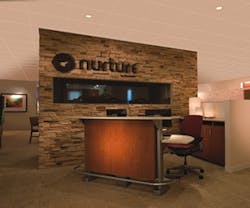Design Collaborative: Caregiver Relief
Caregivers in hospitals, clinics and busy doctors’ offices need spaces that are efficient and that facilitate their work. The technology used in nursing stations has changed significantly over the years, and the workstations used to accommodate the needs of nurses, therapists and doctors also needed to change to meet even more sophisticated, emerging trends. Enter SYNC™, a new seamless system designed to provide relief for caregivers.
Officials at Nurture by Steelcase are committed to offering a full portfolio of products to meet the needs of healthcare professionals, and believed it was time to address the products offered for caregiver stations.
“There have been some good design solutions for this facility component, but these were often satisfied with office products,” says Alan Rheault, director of product design for Nurture. “We wanted to design a product line specifically for nurses and other healthcare professionals based on the way they work.”
Rheault and others at Nurture called upon the A/E/C firm HDR to partner with them on the line based on the firm’s extensive experience designing healthcare facilities. Personnel from Nurture and HDR conducted extensive research in order to develop the foundation for SYNC’s design. Visits to 12 hospitals of varying sizes, located in both urban and rural communities across the country, provided opportunities to observe caregivers in multiple settings. This data was combined with interviews and open discussions with healthcare professionals to paint a clear picture of what was needed.
The Design Process
Meeting the ergonomic needs and work preferences of caregivers is easily accommodated through SYNC’s height options, which provide solutions for seated, service counter or standing use. SYNC is installed on-site, which is more economical and dramatically lessens its environmental impact.“Our team found that the staff at many hospitals was often adapting millwork to meet their needs, and that a number of their behaviors were influenced by their setting,” says Rheault.
The team also took into account current industry trends, including an older average age for nurses, increased technology demands, and increased requirements for infection control. In particular, the team noted there was a critical need to accommodate computers, screens and wiring associated with information gathering requirements. SYNC’s design responds to these industry conditions while also taking into account a number of facility issues.
SYNC was designed to “connect people to people and people to technology.” This is achieved through a unique design and provisions for technology that can be used in a centralized or decentralized configuration. The work surface has gentle curves, which allows caregivers to both move freely and to congregate around the station.
Centralized stations come in single- or double-sized applications, and in three fixed heights—28½ inches, 36 inches and 42 inches—to provide solutions for seated, service counter or standing use. Widths are available in 1-foot increments from 5 to 9 feet.
The decentralized stations feature adjustable height, fixed or combination surfaces in eight shapes to support the needs of individual caregivers, and have an adjustable range from 23 to 48 inches in height. In the two-person configuration, each station can be adjusted individually from one structure.
“SYNC’s use can ebb and flow as the day goes on and gives caregivers the ability to find the height that is best for the work they are doing,” explains Marcia Vanden Brink, director of product design at HDR. “It’s a very flexible and ergonomic solution.”
Other features showcase the product’s integrated and thoughtful design. While the top supports collaboration between users, the slatwall holds accessories and tools. Other features include floor-mounted base structures, tool-less entry for utility areas, seamless work surfaces, LED monitor “nightlights” to enhance the work environment during all shifts, and integrated technology support to hide, protect and keep the work-station clear of cords.
A key benefit, other than SYNC’s design features, relates to its installation. “SYNC is installed on-site rather than being constructed,” says Vanden Brink. “This is more economical and also significantly reduces construction dust, which has a huge environmental impact. In addition, the beam structure of the decentralized station easily adjusts plus or minus 6 inches in width to accommodate the actual dimensions of the space at the time of installation.”
SYNC easily adapts to multiple settings and can be easily moved, giving the product a high reuse value. The steel structure is of high recycled and recyclable content, and the edge bands used on work surfaces and tiles are PVC-free.
SYNC has been well received by both designers and healthcare professionals, according to both Rheault and Vanden Brink. Nurture received a Nightingale Award for the line at the Healthcare Design 08 Conference, but the company is not resting on these types of industry accolades, as Rheault notes that they are already working on the next step for this caregiver workspace solution.
Janet Wiens is a freelance writer based in Memphis, TN. She was formerly marketing manager for HNTB and now works with industry clients to address their marketing and public relations needs. She can be reached at [email protected].
